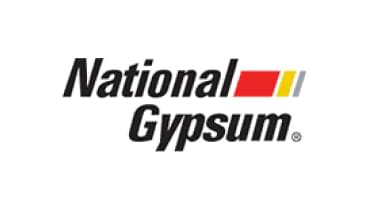National Gypsum Company
National Gypsum was one of the largest asbestos product manufacturers of the 20th century. Asbestos litigation forced the company into bankruptcy in 1990. Approximately $347 million was put into a trust fund to handle future asbestos claims.

National Gypsum’s Connection to Asbestos
National Gypsum began in 1925 and started using asbestos in its products in 1933. Named for a $5,000 “gold bond” guarantee it once offered, asserting its premium wallboards were superior to competitors’ products, Gold Bond became its most well-known product. Under the Gold Bond brand, National Gypsum made many building materials containing asbestos.
National Gypsum bought other companies, including Universal Gypsum and Atlantic Gypsum. The company began making products under 3 major brands: Gold Bond, ProForm and PermaBase. It used asbestos in at least 30 different building products.
National Gypsum’s Top Asbestos-Containing Products
- Chromatex Siding Shingles
- Insul-Best Panels
- Joint Cement
- Panelectric Groove Fill
- Perfect Spray
- Perfo-Lyte Acoustical Plaster
- Rockwall Acoustical Plaster
- Spackling Compound
- Topping Cement
- Woodgrain Siding Shingles
National Gypsum stopped using asbestos in its products in the early 1980s. As of 1985, the company was facing around 4,500 lawsuits because of the health effects of asbestos exposure.
Asbestos is the primary cause of mesothelioma. Breathing in asbestos fibers can also cause other serious asbestos-related diseases like lung cancer and asbestosis.
Who Was at Risk of Asbestos Exposure From National Gypsum?
Workers who made National Gypsum’s asbestos products faced a high risk of breathing in toxic asbestos fibers. Anyone who worked in the company’s factories could be exposed and potentially develop mesothelioma because the tiny fibers floated in the air.
Construction workers who installed, cut or disturbed National Gypsum’s asbestos products were also at higher risk for exposure. A comprehensive review from 2024 that studied asbestos exposure among construction workers reported, “The construction sector is the highest, compared to other sectors or industries, to be exposed to asbestos.”
Occupations at Risk of Handling National Gypsum’s Asbestos Products
- Building maintenance workers
- Carpenters
- Cement workers
- Construction workers
- Demolition crews
- Drywall workers
- Insulators
- Painters
- Pipefitters
- Sheetrock workers
Previous research has shown drywall workers were especially at risk of exposure before the mid-1970s because joint compounds contained chrysotile asbestos. Workers who sanded joint compound had the highest levels of asbestos in the air around them. General construction workers and people who did DIY home repairs were also at risk.
When workers can unintentionally bring home asbestos dust on their clothing, hair or skin, their loved ones may experience secondary exposure. Similar to primary exposure, secondary exposure can cause mesothelioma or other asbestos-related diseases.

Gain access to trust funds, grants and other forms of compensation for you or your loved ones.
Get Help NowMesothelioma Lawsuits Involving National Gypsum
National Gypsum was facing about 45,000 unresolved asbestos lawsuits by 1992. Many of these cases were settled out of court or dropped.
Notable Asbestos Lawsuits Against National Gypsum
- $8.4 million: National Gypsum paid this award in 1987 to school districts in 19 states for asbestos-related damages.
- $6 million: A jury in El Paso, Texas, awarded this amount in 1999 to the family of Patricio Sanchez Jr., a school janitor who died from mesothelioma after decades of exposure to asbestos-containing joint compounds, including National Gypsum’s Gold Bond products.
- $114,800: Mercer University sued National Gypsum and 3 other companies in 1985 for selling asbestos-containing materials. The money was used to cover construction costs.
When the company filed for bankruptcy in 1990, all lawsuits were paused. In 1993, an asbestos trust fund was set up to handle these claims. Since then, the trust has handled all asbestos-related claims.
National Gypsum Asbestos Trust Funds
The company joined an industrywide settlement called the Wellington Agreement in 1985 that created the National Claims Facility. This was a voluntary system in which asbestos companies and insurers jointly handled claims, but people could still choose to sue in court. Payouts were determined individually and could vary widely.
In contrast, asbestos trust funds are set up when a company goes bankrupt, and claims must go through the trust instead of the courts. These trusts pay set amounts based on disease type and often cover only part of a claim’s value to preserve funds.
The National Claims Facility ended after only 3 years. Owing more than $1 billion, mostly from asbestos lawsuits, National Gypsum went bankrupt in 1990. The company emerged from bankruptcy in 1993 and created the National Gypsum Corporation Settlement Trust to handle future asbestos claims. The company funded the trust with more than $5 million in cash and $600 million in insurance policies.
As of 1997, the trust didn’t have enough money for future claims. The company filed for bankruptcy again in 2002 to reorganize and add more money to the trust. In 2003, the National Gypsum Company Bodily Injury Trust was created with $347 million to process future claims. Currently, the trust pays 41% of the amount requested, which is higher than most other asbestos trusts.
Legal Help for Survivors Exposed to National Gypsum’s Asbestos
If you have mesothelioma or lung cancer as a result of National Gypsum’s asbestos products, an experienced mesothelioma lawyer can help you seek money for your medical bills and other costs. There are often time limits for filing with an asbestos trust fund. Your attorney can help ensure your claim is filed properly and on time.
Patient Advocates at The Mesothelioma Center are available 24/7 to help you and your family. They can answer your questions, connect you with medical specialists for second opinions or treatment, match you with legal experts who are familiar with cases like yours and offer support throughout your mesothelioma journey.
Recommended Reading


